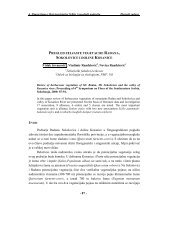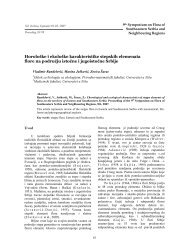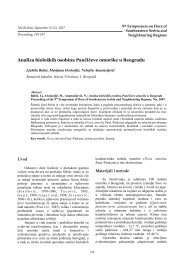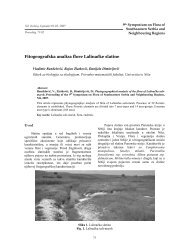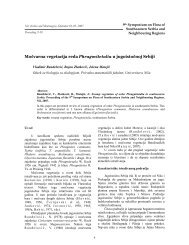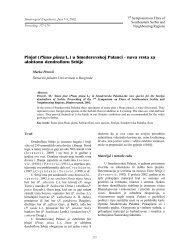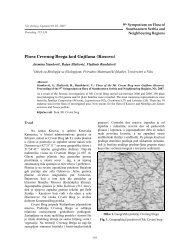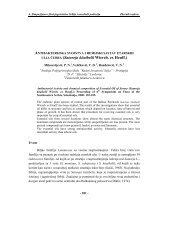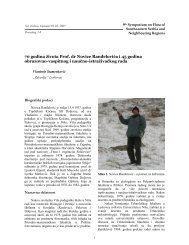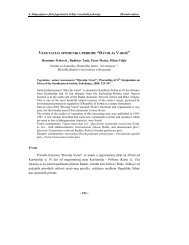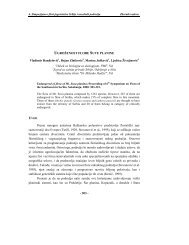10th Symposium on the Flora of Southeastern Serbia and ...
10th Symposium on the Flora of Southeastern Serbia and ...
10th Symposium on the Flora of Southeastern Serbia and ...
You also want an ePaper? Increase the reach of your titles
YUMPU automatically turns print PDFs into web optimized ePapers that Google loves.
10 th <str<strong>on</strong>g>Symposium</str<strong>on</strong>g> <strong>on</strong> <strong>the</strong> <strong>Flora</strong> <strong>of</strong> Sou<strong>the</strong>astern <strong>Serbia</strong> <strong>and</strong> Neighbouring regi<strong>on</strong>s,Vlasina 17 to 20 June 2010caranti<strong>on</strong> plantlets were left to grow in natural places where <strong>the</strong>y bloomed. In future,<strong>the</strong>se ''in vitro'' carnati<strong>on</strong> plantlets will be reintroduced in nautural enviroment.Important <strong>of</strong> in vitro horse chestnut <strong>and</strong>rogenic embryosproducti<strong>on</strong>Ćalić, D. 1 , Radojević, Lj. 11 Institut za biološka istraživanja „Siniša Stanković“, Beograd, Srbijadusica.calic@gmail.comThe aim <strong>of</strong> this research was to study influence <strong>of</strong> activated charcoal (AC),abscisic acid (ABA) <strong>and</strong> polyethylene glycol (PEG) <strong>on</strong> <strong>the</strong> maturati<strong>on</strong> <strong>and</strong>c<strong>on</strong>versi<strong>on</strong> <strong>of</strong> horse chestnut <strong>and</strong>rogenic embryo for <strong>the</strong> diversity protecti<strong>on</strong> <strong>and</strong>c<strong>on</strong>servati<strong>on</strong> <strong>of</strong> horse chestnut. Horse chestnut (Aesculus hippocastanum L.,Hippocastanaceae) represent a relict species <strong>of</strong> <strong>the</strong> tertiary flora <strong>and</strong> endemit <strong>of</strong>Balkan peninsula. The comm<strong>on</strong> name horse chestnut is reported as having originatedfrom <strong>the</strong> err<strong>on</strong>eous belief that <strong>the</strong> tree was a kind <strong>of</strong> chestnut, toge<strong>the</strong>r with <strong>the</strong>observati<strong>on</strong> that eating <strong>the</strong>m cured horses <strong>of</strong> chest complaints. Horse chestnut treesare native to <strong>the</strong> Balkan peninsula, but grow as ornamental trees in parks <strong>and</strong>avenues throughout <strong>the</strong> Nor<strong>the</strong>rn Hemisphere. Because <strong>of</strong> <strong>the</strong> slow <strong>and</strong> difficultreproducti<strong>on</strong> <strong>of</strong> great importance to be fast <strong>and</strong> cheap in vitro multiplicati<strong>on</strong>.Possible soluti<strong>on</strong> is regenerated by <strong>and</strong>rogenesis. An<strong>the</strong>r culture has been used inrecent years as a tool for producing haploid plants in a varyety <strong>of</strong> higher plants, but<strong>the</strong> low frequencies <strong>of</strong> microspore-derived plants restrict <strong>the</strong> use <strong>of</strong> <strong>the</strong> technique inplant breeding. There are several factors affecting <strong>and</strong>rogenesis in horse chestnut,such as genotypes, growth <strong>of</strong> d<strong>on</strong>or plants, pretreatments <strong>of</strong> an<strong>the</strong>rs, compositi<strong>on</strong> <strong>of</strong>medium <strong>and</strong> culture c<strong>on</strong>diti<strong>on</strong>s. Androgenic embryos originating from microspores<strong>and</strong> an<strong>the</strong>r culture were maturated over 90 days. Androgenic embryos <strong>on</strong> mediac<strong>on</strong>taining PEG (50 g l-1), in combinati<strong>on</strong> with AC (1 g l-1) showed a rapiddevelopment <strong>of</strong> embryos in <strong>the</strong> cotyled<strong>on</strong>ary stage <strong>and</strong> lowered percentage <strong>of</strong>abnormal structures. The best results <strong>of</strong> <strong>and</strong>rogenic microspore embryo germinati<strong>on</strong>was observed <strong>on</strong> media supplemented with AC al<strong>on</strong>e (99%), <strong>and</strong> in combinati<strong>on</strong>with PEG (100%). Also, <strong>the</strong> greatest number <strong>of</strong> <strong>and</strong>rogenic microspore plants (18%)<strong>and</strong> <strong>and</strong>rogenic an<strong>the</strong>r plants (12%) were formed <strong>on</strong> media enriched with 1 % AC.Lowest germinati<strong>on</strong> percentages, 37 % <strong>and</strong> 39 % in microspore culture <strong>and</strong> 33 %<strong>and</strong> 38 % in an<strong>the</strong>r culture were obtained <strong>on</strong> maturati<strong>on</strong> media with ABA 20 mg l-1al<strong>on</strong>e <strong>and</strong> in combinati<strong>on</strong> with AC 1g l-1. Flow cytometric analysis showed thatmost <strong>of</strong> <strong>the</strong> <strong>and</strong>rogenic embryos were haploid, corresp<strong>on</strong>ding to <strong>the</strong>ir microsporeorigin, while half <strong>of</strong> <strong>the</strong>se became diploid, after maturati<strong>on</strong> for 90 days. Allregenerants originating from microspore culture were haploid immediately after76



